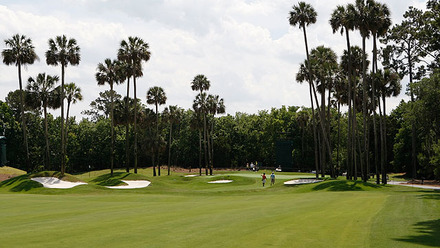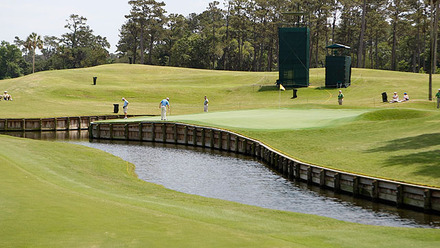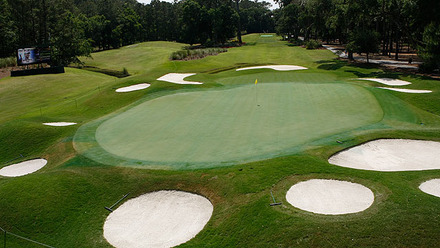Inside The PLAYERS Stadium Course at TPC Sawgrass
Talk about inauspicious debuts.
In 1982, when the PLAYERS Championship switched venues from Sawgrass Country Club in Ponte Vedra to the new Stadium Course at the TPC Sawgrass on the west side of Highway A1A, the reaction from the playing pros was, let’s just say not warm.
The TPC, as it became known to the players (the new course was the idea of commissioner Dean Beman and owned and operated by the PGA Tour Players Association), was unlike anything they’d ever seen or played. Constructed atop 415 acres of a dense swamp inhospitable to anything but deer, wild hogs, venomous snakes, mosquitoes and alligators, architect Pete Dye didn’t so much tame the land as make it newly inhospitable to touring pros.
The golf course was a brutal, unkempt configuration of water, waste bunkers, moguls and mounds covered in wiry roughs “maintained” by an imported herd of goats, greens with dizzying contour and, of course, high earth embankments that provided stadium-style seating for spectators. Playing it demanded unlikely degrees of power, finesse and nerve. It made the players think, and sweat. More often than not it embarrassed them.
The initial reaction to the TPC produced a colorful array of comments, or more accurately, grumbles. New York Times writer Dave Anderson called it “Aztec ruins set among the Everglades.” Players who thought it too difficult bemoaned the ruination of a good swamp, calling it a combination of horse manure and luck. Because of all the wooden railroad ties that lined the hazards, one player said it was the only golf course in the world that could burn down.
“Where are the windmills and animals?” asked Fuzzy Zoeller.
“What I’m still trying to find out,” said John Mahaffey, “is if you win a free game if you make a putt on the last hole,”
Lost balls and ever-present trouble led to five-hour rounds. Ed Sneed said, “Pete Dye ought to be fined for slow play,”
As much as anything, the TPC confounded players with its small, highly–some said overly–contoured putting surfaces.
”Nice course you got here,” Miller Barber said after a preview round. ”When are you gonna put in the greens?” Jack Nicklaus echoed the sentiment: “I’ve never been very good at stopping a 5-iron on the hood of a car,” he said.
Then, of course, there was the immediately infamous—and now world famous—par three 17th, the island green, a concept Dye says he and wife Alice came up with because they had run out of every other novel idea. Writer Dan Jenkins, in Sports Illustrated, dubbed it “Fantasy Island.”
“The 17th is a hole that only the Marquis de Sade could love—or Pete Dye, if that’s not redundant.” wrote Anderson in The Times. Twenty golf balls went in the water at the 17th during the first live tournament round, 52 total in four days, and those in weather relatively calmer than was typical during the PLAYERS.
When the tournament was over, the survivor, er, winner, Jerry Pate, threw Pete Dye into the lake next to the 18th green.
Dye’s TPC course, unbelievably, made players nostalgic for the old Sawgrass across the street, a course otherwise known as “mean-spirited” and which yielded winning scores of over par when the winds blew 40 and 50 mph as they were known to do. After the 1983 event, a group of players drafted a petition demanding alterations. This was, after all, a club they werw ostensibly the owners of, and they were suffering acute buyers’ remorse. Nicklaus, Tom Watson, Craig Stadler, Hale Irwin and Tom Weiskopf, who said the TPC was “like playing inside a pinball machine,” were among those who signed it. A player advisory committee, which included Nicklaus, Dye’s design partner at Harbour Town over a decade earlier, drafted a list of specific recommendations.
The public, however, loved what it saw, especially the sink or swim nature of the design and the schadenfreude they experienced watching the professionals acting just as perplexed as them. They especially liked watching them dump balls into the water at the island green 17th. They’ve been flocking to the course ever since.
What’s notable in all this is that, as unlikely as it seemed in 1982, at least if you asked the players, the TPC today is widely regarded as one of the best courses in the United States and among the most popular in the world. So what changed? Did the TPC mature into a better course, a more friendly tournament venue, or did the players and public simply begin to adapt and accept this new radical style of architecture?
The answer is, both.
The TOUR, and Dye, responded to the formal criticisms by modifying the golf course for the 1984 PLAYERS, primarily softening the contour on a majority of greens and drastically reducing the roughs—no more goats.
In subsequent years the course evolved even further, shedding the most telling signs of its former sadistic, inchoate self while flattening and widening out to better accommodate windy conditions and those Nicklausian 5-irons. The pros increasingly took advantage of the changes with lower and lower scores, highlighted (or low-lighted if you’re Pete Dye) by Greg Norman’s 20-under par victory in 1994.
Structurally the course remained the jungle gym Dye originally conceived—the 17th hole is still a particular persona non-grata among the pros—just without so many tacks on the bars.
In 2006, Pete Dye returned to oversee a dazzling $10 million, 14-month re-modernization of the Stadium Course in preparation for the 2007 PLAYERS Championship. He began by stripping the entire course down to its 1981 bones, then replaced the miles of outdated piping with computer-controlled drainage and irrigation systems and new SubAir units before trucking in nearly 27,000 tons of sand to replace the deteriorating topsoil.
After rebuilding, re-contouring and re-grassing the entire course—tees, greens, bunkers, lakes and spectator mounding—the finished product is today perhaps the most state-of-the-art playing surface in the game. When you conduct your business on it, figuring out not just the speed of the greens but the bounce and drift of the ball across the firm fairways adds yet another mental dimension to what is already one of the greatest psychological tests in golf.
By now, most golf viewers feel they know the course, even if they haven’t played it. Especially the final three holes, which get so much attention on television due to the high drama quotient: the risk/reward par five 16th, the island 17th, and the long, demanding par four 18th.
Prior to that, however, the TPC throws at you a staccato tom-tom beat of individual moments that can make or break a good round, or at least stick in your head a long time afterward. We’ll take a look at some of the mesmerizing but often overlook spots and shots around the course.
Approaching the Fort 4th
The 4th hole is just 384 yards during The PLAYERS (you’ll play it at around 350 yards) so the approach is typically just a juicy little short iron or wedge after a positioning tee shot. It’s one of the most anticipated in the round because if you can control your distance (and your nerves) you’ll have a good look at birdie. When the pin is cut toward the front of the green you can even use the middle slope to suck the ball back to the hole, just like the pros do.
But it can also be one of the most infuriating. The tiny green—so tantalizing, so surrounded in armor—sits just over a canal ringed by pot bunkers and grassy swales, and missing it even slightly creates one of the most difficult pars on the course, assuming you’re not wet, and a supreme feeling of lost opportunity.
The Drive for 5
The tee shot at the 5th is across a corner of a lake on the kind of perfect diagonal angle—inviting, yet slightly disorienting—that Dye seems to have patented. You want to bite off as much water as possible to get the ball down this 471 yard hole (for the pros; 422-461 for most of us), but the water, slight elevation of the semi-blind fairway and long waste bunker on the short side invariably force you to bail out slightly left, where the drive has a tendency to run through the fairway.
Executing a power fade that reaches the target zone is one of the most enjoyable driving sensations at the TPC, but you’ll likely be feeling something else when hitting your hybrid into this green from the rough or sand.
Threading the (Pine) Needles at 6
Six is another sub-400-yard par four where, like at four, it’s vital to drive the ball in a fairway that’s only about 25 yards wide. Two sparse groves of pine trees that flank the entry to the green like towering Dwight Howards have been know to reach out and swat balls out of the sky. Threading them and finding the surface of this small, elevated and highly contoured green is to pass yet another test on your TPC odyssey.
The Second “Shot” at 8
Though it’s a par three, you’re more than likely to be playing your second shot from off the green at the 8th, which ranges
anywhere from 168 to 237 yards. Nine bunkers of various depths encircle the green and voluminous swales flow out of them and onto the putting surface like the rippling brim of a lady’s sun hat. This complex demands a supreme degree of touch as every chip and recovery pitch turns into a sliding, sweeping adventure. Missing a front pin either left or right creates an almost impossible up and down over two massive shoulders that rise up the apron’s edges.
The Decision at 11
The fairway at the par five 11th is one of the wider ones at the TPC, encouraging you to rip your biggest drive of the day. It wants you in the fairway, because from there you must make what amounts to an existential decision: play like a chicken and bunt your second up the right fairway, leaving a short iron approach; take a more risky 200+ yard shot over two bunker complexes to the left fairway, which opens up a party-time angle to the pin; or strap ‘em on and go for the green over water and the famous moat of sand that surrounds the perched putting surface.
It’s moments like these that define your character, and no matter your decision, unless you walk away with birdie or par you’ll always wonder what if I chose the other…
The 14th: Man’s Game
Another wide fairway awaits you at the monstrous 481-yard 14th (377 to 436 from the middle sets), but even assuming you can find it (not a given—the big mounds in the right rough are like ball magnets) you’ll still be left a long way from home.
Slightly elevated, angled behind a depressed bunker, surrounded by more rough-covered mounds, pot bunkers and swales and imbued with enough swells and troughs to funnel golf balls in four different directions, the 14th has arguably the TPC’s most difficult green complex. Simply, you need to hit the shot of the day to get there, knowing that if you can find some part of the green you’ll have done something many of the pros won’t be able to do.
The One Shot
We said we weren’t going to mention it, but we have to. Love it or hate it, the 17th hole is reason enough to make the trip to Ponte Vedra, at least once. It can be one of the most memorable and defining experiences in a golfer’s life: To stand on the tee, to gaze across the pond, to look the almost mythical island green in the eye. To feel the nerves as you stand over the ball and grip your club. And maybe most importantly, to be able to answer that ultimate golf cocktail question when someone asks it: what did you do on the 17th?
STAYING
The 532-room Marriott Sawgrass Resort & Spa has entered the second significant phase of its life after a two year, $16 million renovation (finished in 2007) that brought the rooms out of their 1980’s funk and up to the standards of a 21st century luxury hotel.
Arranged around a multi-storied glass atrium overlooking the lobby and mezzanine, the rooms are now brighter and contemporary with new wood furnishings and accents, marble surfaces in the spacious bathrooms, new bedding and flat-panel televisions. Additionally the 20,000-square foot Spa at Sawgrass opened in 2005, replacing the former facility that was little more than a massage room near a cramped workout area on the ground level of the hotel.
In addition to access to a total of eight golf courses, including Dye’s Valley Course, the Marriott Sawgrass Resort has four outdoor pools, walking and biking paths, 11 ATP tennis courts and quick access to its beach club. V. Kelly’s, a new Irish-themed pub on the lower level of the lobby with a wide whiskey selection, is always a popular after hour’s denouement.
THE EXPERIENCE
The coup de grace of the TPC Sawgrass revitalization experience is the addition of a 77,000 square-foot Mediterranean Revival-style clubhouse that commands the view behind the 9th and 18th greens. You can get lost inside this massive building, which cost over $30 million to construct and is 40 percent larger than the White House.
A spacious guest locker room with polished wood lockers is almost as impressive as the pros locker room, located in a separate private wing. A grand staircase takes you to an upper floor restaurant, private meeting rooms and patio that overlooks the course. The common areas feature limestone floors and walls and hallways lined with golf memorabilia and murals commemorating historic moments at THE PLAYERS, including Pate and Dye’s 1982 famous victory bath. No matter what happens on the Stadium Course, this is a reason to look forward to the end of your round.
DINING
Inside the hotel, recharge with a chop, lobster tail and big bottle of red at the handsome Augustine Grill. Better yet, take the shuttle ride a few blocks over to the beach to the Cabana Beach Club and 619 Ocean View, an airy upper level restaurant of the where you’ll enjoy the region’s fresh seafood while watching the Atlantic tide roll in an out.
800-457-4653





